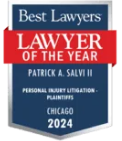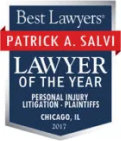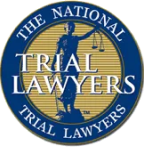Cerebral Palsy Lawsuit Stages
If your child suffers from cerebral palsy or a similar birth injury because a doctor, nurse or other medical professional provided improper care, they are a victim of medical malpractice. Illinois law provides a way for birth injury victims and their parents or guardians to recover compensation from a negligent healthcare provider. One approach is to file a cerebral palsy injury lawsuit.
About Our Cerebral Palsy Attorneys
 The Chicago cerebral palsy attorneys at Salvi, Schostok & Pritchard P.C. have four decades of experience in complex civil litigation in Illinois. We know how to investigate and gather evidence in medical malpractice cases in connection with cerebral palsy and other birth injuries. We also have a network of medical experts to consult, and we know how to combine all available evidence and expertise to present a persuasive case.
The Chicago cerebral palsy attorneys at Salvi, Schostok & Pritchard P.C. have four decades of experience in complex civil litigation in Illinois. We know how to investigate and gather evidence in medical malpractice cases in connection with cerebral palsy and other birth injuries. We also have a network of medical experts to consult, and we know how to combine all available evidence and expertise to present a persuasive case.
Filing a Cerebral Palsy / Birth Injury Lawsuit
If you decide you want to pursue a legal claim with the assistance of Salvi, Schostok & Pritchard P.C.’s Chicago cerebral palsy injury lawyers, the first step will be to file a civil lawsuit.
Pursuing a lawsuit on the basis of a child’s cerebral palsy injury can be a lengthy and complex process, and one should be aware of time limits on cerebral palsy lawsuits. Hospitals, obstetricians, physicians and other medical practitioners will not readily admit to medical errors or negligence. Insurance companies are not eager to make payments to injured parties, regardless of how deserving they may be.
The Chicago cerebral palsy injury attorneys of Salvi, Schostok & Pritchard P.C. have recovered significant settlements and verdicts in cerebral palsy injury lawsuits filed in Chicago and other Illinois courts. Justice can be won for children and parents whose lives have been forever marred by medical error and/or negligence.
Filing a Complaint
The initial filing in the lawsuit will be called the “complaint.”
A complaint contains factual allegations and states legal claims for relief, which may include compensation for past and future medical costs and for pain and suffering.
A complaint may be filed in state or federal court. In some circumstances, a defendant (the individual or institution that is sued) may have the case removed to federal court. The defendant may also file an “answer” to the lawsuit to state their version of what happened.
Discovery, Depositions and Motions in a Cerebral Palsy Injury Lawsuit
After your complaint is scheduled by the court, or “docketed,” and the defendant has filed their answer, pre-trial proceedings such as discovery, depositions and motions will begin.
Discovery
In a cerebral palsy injury or other kind of birth injury lawsuit, pre-trial discovery will involve requests for medical documents, requests for admissions to certain facts and requests for answers to written questions called “interrogatories.” Discovery can be time-consuming.
Depositions
A lawsuit’s pre-trial phase also involves numerous “depositions,” in which attorneys for each side interview potential witnesses. Depositions are taken under oath before a court reporter. Defendants in the lawsuit will likely take depositions from you (the plaintiff), your family and your medical providers. Your attorneys will depose the doctors, nurses, technicians and others involved with your child’s delivery and prenatal and post-natal medical care.
Both sides of the lawsuit will consult individuals certified as “experts” by the court, who may testify about medical issues in the case. They will provide depositions, which, in some instances, may be used instead of having them testify in court.
Motions
Pre-trial proceedings also usually involve numerous “motions,” which are formal requests for the trial court to rule on such matters as forcing a party to the suit to take a specific action, or for the court to exclude evidence or to clarify a procedural issue. In civil litigation, defendants commonly file pre-trial motions that ask the court to dismiss some or all of the claims asserted or to dismiss some of the parties from the suit.
Settling a Cerebral Palsy / Birth Injury Lawsuit
When your attorneys have developed a strong and persuasive case of medical error or negligence, the doctors or healthcare provider, or their insurance company, may decide it is in their best interests to negotiate an out-of-court settlement. This may happen before the lawsuit is filed, or after the suit has been filed but before a jury’s verdict has been rendered.
A settlement is a monetary offer to you, the plaintiff. It is meant to settle and end the case. It’s your decision on whether to settle your lawsuit. Your Salvi, Schostok & Pritchard P.C. cerebral palsy injury attorney will notify you of any settlement offer the defendant makes and advise you about the prospects for your lawsuit in court and your legal options. Your attorney will negotiate on your behalf for more compensation if that is appropriate but will not agree to any settlement offer unless you direct them to do so.
Deciding to Agree to a Settlement
A settlement offer must be thoughtfully considered. By agreeing to a settlement, you absolve the healthcare provider of any further liability. You most likely will be required to keep the details of a settlement confidential, and the defendant will not admit to any fault in the matter.
Settling is often a faster and less stressful resolution to a legal matter than going to court. A settlement also provides a guaranteed outcome, as opposed to the risk of going to trial and getting nothing.
Taking Your Cerebral Palsy / Birth Injury Lawsuit to Trial
If a settlement cannot be reached, you and your Chicago cerebral palsy injury lawyer will go to trial with your lawsuit. You will get your day in court.
At trial, both sides will have the opportunity to present evidence. Your Salvi, Schostok & Pritchard P.C. birth injury lawyer will have fully prepared you to testify. You and additional witnesses will present testimony under questioning by your attorney as well as the defendant’s attorney.
Deciding a Verdict and Obtaining Compensation
Once both sides’ evidence has been presented, the jury will receive instructions as to the issues on which it will base a verdict. Based on the jury’s verdict, the court will enter a judgment that may include damages (i.e., compensation) awarded to the plaintiff.
You might be awarded damages that are more than the compensation offered in a settlement. However, the risk of going to trial is that a jury could side with the defendant, which means you will not be awarded compensation.
Post-Verdict Motions / Appeal
Once the jury has a verdict, and the court enters a judgment, either party in the lawsuit can file post-trial motions. The defendant may ask the court to set aside a negative verdict or ask for a judgment notwithstanding the verdict.
The plaintiff or defendant may file an appeal if they are not happy with the jury verdict or the court’s judgment. An appeal asks the appellate court to review what occurred at trial and decide whether there were legal errors that warrant relief. Relief may include an order for a new trial.
If the jury’s verdict and/or the court’s judgment are not to your benefit, your Salvi, Schostok & Pritchard P.C. attorneys will review the trial records to determine whether an appeal is appropriate. We will advise you of our findings and legal opinions. There will be no motion for appeal on your behalf without your approval and consent.







